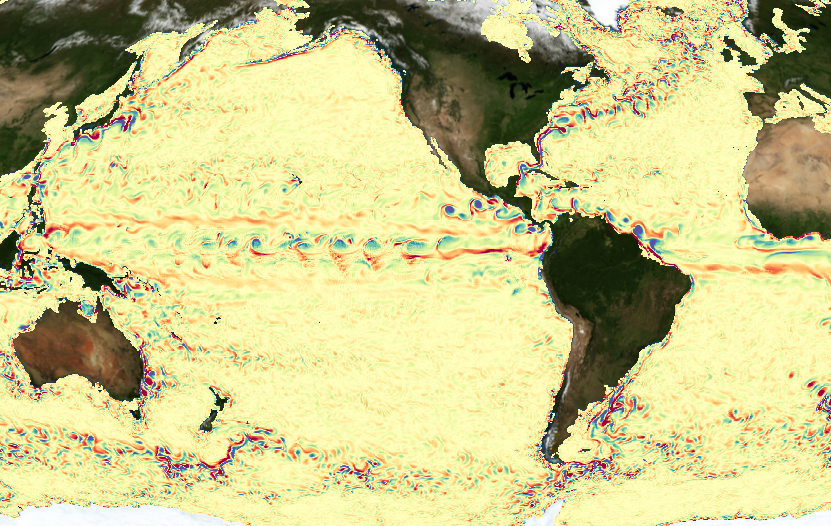Ocean Model Working Group
Building GFDL's next ocean model configuration
Bio
(used for those awkward introductions before talks, or to put in proceedings when fund raising)
 Alistair Adcroft received his PhD in Physics from Imperial College, London in 1995, and carried out postdoctoral research at UCLA with David Neelin as a UCAR Ocean Modeling Postdoctoral Fellow.
He subsequently worked at MIT for seven years, first as a research scientist and then as a principal research scientist.
While at MIT, Adcroft was one of the lead developers of MITgcm, which is now a widely used process-study and large-scale non-hydrostatic ocean (and atmosphere) model.
He joined the Atmospheric and Ocean Sciences Program at Princeton University as a Research Oceanographer in 2003, in order to work closely with colleagues at the NOAA Geophysical Fluid Dynamics Laboratory.
Adcroft was involved in the development of the ESM2G and ESM2M earth system models, and more recently led the Ocean Model Development Team that developed GFDL’s latest ocean-ice model, OM4.
Adcroft’s primary research interests are in numerical methods, algorithms and formulations used in general circulation models of the ocean and atmosphere, parameterization of sub-grid scale processes and high-performance computing.
Adcroft serves on several advisory boards, the Scientific Steering Committee for CESM, and on the CLIVAR Ocean Model Development Panel.
He was recognized by AGU for his contributions to ocean modeling with the 2021 Ocean Sciences Award.
Alistair Adcroft received his PhD in Physics from Imperial College, London in 1995, and carried out postdoctoral research at UCLA with David Neelin as a UCAR Ocean Modeling Postdoctoral Fellow.
He subsequently worked at MIT for seven years, first as a research scientist and then as a principal research scientist.
While at MIT, Adcroft was one of the lead developers of MITgcm, which is now a widely used process-study and large-scale non-hydrostatic ocean (and atmosphere) model.
He joined the Atmospheric and Ocean Sciences Program at Princeton University as a Research Oceanographer in 2003, in order to work closely with colleagues at the NOAA Geophysical Fluid Dynamics Laboratory.
Adcroft was involved in the development of the ESM2G and ESM2M earth system models, and more recently led the Ocean Model Development Team that developed GFDL’s latest ocean-ice model, OM4.
Adcroft’s primary research interests are in numerical methods, algorithms and formulations used in general circulation models of the ocean and atmosphere, parameterization of sub-grid scale processes and high-performance computing.
Adcroft serves on several advisory boards, the Scientific Steering Committee for CESM, and on the CLIVAR Ocean Model Development Panel.
He was recognized by AGU for his contributions to ocean modeling with the 2021 Ocean Sciences Award.
Adcroft’s thesis work on the finite volume formulation of ocean models has become a foundation of modern ocean models, particularly for accurate representation of bottom topography. He has since extended these ideas to parameterize the effects of unresolved topography on the mean flow, demonstrating that the geometric consequences of topography on Tsunami arrival time can be captured as accurately in coarse resolution models as in fine resolution models. He has examined the impact of relaxing fundamental assumptions in the formulation of ocean models, including the hydrostatic and Boussinesq approximations and nature of physical boundary conditions. His interest in what controls the large-scale circulation of the ocean has involved modeling studies ranging from geothermal heating of the ocean, analysis of ocean heat transport and data assimilation.
Adcroft’s early research at Princeton on new vertical coordinates, high order methods, and vertical coordinate algorithms, recently formed the basis of the latest GFDL ocean code, MOM6. His involvement in the development of GFDL’s ocean models has also involved the parameterization of mesoscale eddies and mixing over topography. In response to the bias in earlier climate models, he developed a particle model of icebergs that transport fresh [frozen] water from the ice-sheets to the open ocean where they melt. This model has been extended to represent giant tabular icebergs via conglomerates of bonded particles and has been used to simulate ice shelf collapse and the decay of giant icebergs. The emphasis of his ongoing research remains in the realm of numerical methods and computational mathematics, including machine learning.
